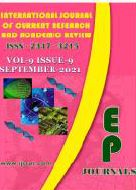Abstract Volume:9 Issue-9 Year-2021 Original Research Articles
 |
Online ISSN : 2347 - 3215 Issues : 12 per year Publisher : Excellent Publishers Email : editorijcret@gmail.com |
Debre Markos, Ethiopia
2Ethiopian Institute of Agricultural Research, Jimma Agricultural Research Center, P.O.Box 92, Jimma, Ethiopia
Nitrogen is the most yield-limiting nutrient for maize growth and development as in most soils of the study area and it needs effective management option to enhance crop production. Adoption of appropriate management may overcome N lose and enhance its use efficiency in crop plants which are associated with soil and crop management and include appropriate source and timing of application. Thus, afield experiment was done with an objective to determine mineral N fertilizer source and time of application on agronomic parameters and yields of maize on Nitisols of Kersa and Tiro Afeta District Southwestern Ethiopia during 2017/18 cropping season. The experiment was laid out in RCBD having eight treatments with three replications. Soil sample was taken at a depth of 0-20 cm before treatment application. The soil result showed moderately acidic in reaction, sandy clay texture, low in Tot. N and Av.P and medium in K, OM and CEC at both tested sites. The collected data was subjected to ANOVA using SAS 9.3 version software. LSD test was used to separate means at 5% level of significant. Grain yield, Biomass yield and AE were highly affected by time, rate and N source. The highest grain yield (7067.4 kg ha-1atKersa and 8178.1 kg ha-1 at Tiro Afeta) and biomass in average (21.5 t ha-1) were obtained from application of 138 kg ha-1 N from urea stable in splits while the lowest grain yield (3251.4 and 3145.4 kg ha-1) and biomass yield (14.75and 11.39 t ha-1) were recorded from control at both sites, respectively. The highest Agronomic Efficiency of Nitrogen (41.29 kg kg-1) at Kersa and (52.10 kg kg-1) at Tiro Afeta was responded from plots treated with 46 kg ha-1 N and 138 kg ha-1 N urea stable respectively. Moreover, application of 138 kg ha-1 N from urea stable in splits provided the maximum net benefit of 61701.93 ETB ha-1 with Marginal rate of return(MRR)(415.28%) at Kersa and 72198.05 ETB ha-1 with MRR (1795.28%) at Tiro Afeta. Therefore, application of 138 kg ha-1 N from urea stable (treated with urease inhibitor) in splits is recommended for farmers to maximize maize production thereby reducing nitrogen lose at high soil moisture conditions.
How to cite this article:
Habetamu Getinet and Obsa Atnafu. 2021. Evaluating Yield and Agronomic Efficiency of Maize (Zea mays L.) through Application of Urea Stable at High Moisture Condition of Southwestern Ethiopia.Int.J.Curr.Res.Aca.Rev. 9(9): 55-64doi: https://doi.org/10.20546/ijcrar.2021.909.006



Quick Navigation
- Print Article
- Full Text PDF
- How to Cite this Article
- on Google
- on Google Scholor
- Citation Alert By Google Scholar
